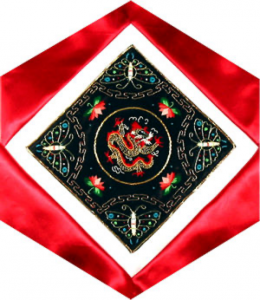China

The Block
The result of the collaborative efforts of Judy Gin, Angela Yick and Eric Lam, this block highlights important designs found in textiles and clothing in China, a country with an extensive tradition of embroidery and woven silk. In the centre is one of many dragons whose legends permeate ancient Chinese civilization and helped shaped the culture. The Chinese proudly proclaim themselves Long de Chuan Ren (descendants of the Dragon) and look upon dragons as the ultimate symbol of good fortune and divine protection. Known as ‘Angels of the Orient’, dragons are evident in the visual arts, literature, poetry and architecture. Couched gold-work encircles the dragon and is used to create the block’s crenellated design, as well as the butterfly in each corner. A pink lotus, symbolizing purity, is embroidered in silk on each side of the block reflecting the importance of these flowers in Chinese culture. The colour red, found on buildings, clothing, and decorations, means good luck and was chosen to frame the embroidered block.
Cultural Profile
China is the world’s fourth-largest country and home to one quarter of the earth’s population. Han people make up the nation’s biggest ethnic group and there are also 56 other ethnic minorities. Putonghua, commonly known as Mandarin, is China’s national language; however, as many as 292 languages and dialects are spoken as well. These languages and dialects share a common writing system, comprised of thousands of logograms, allowing people who do not comprehend each other’s speech to understand each other through the written word.
The Chinese are responsible for many of the world’s technological advances, including the seismograph, the compass, gunpowder, fireworks, paper, navigational systems, principles of accurate map-making and the abacus. Balance and harmony are important themes to the Chinese and permeate all aspects of life. The principles of feng shui, for example, are used to determine the placement of buildings and objects.
China’s highest form of visual art has traditionally been calligraphy, the art of writing Chinese characters. It is found in temples, adorning the walls of caves, the sides of mountains and monuments all over China. Calligraphy’s basic tools, brush and ink, are also the tools of Chinese painting, which emphasizes balance, line and tone.
Textile arts have a long history in China, as the country is credited with the discovery of silk and the development of its production. Primitive silk looms, dating back to 4,000 years BC, have been discovered in the Zhejiang province. China was the final stop on the legendary Silk Road, a trading route extending from the Mediterranean to China, which traders from all countries used to access Chinese textiles, pottery, spices and technical knowledge. Indeed, China was so vital to Western medieval merchants that Columbus tried to find a faster route to China’s riches by sailing West on the Atlantic Ocean.
Silk embroidery and weaving have played an important role during China’s long and rich textile history and that tradition continues to this day . Due to its huge cultural diversity, the country is home to many styles and refinements. One of these, silk brocade called Yunjin (literally meaning cloud brocade since the fabric is so light), is woven in the city of Nanjing using silk, gold and silver thread. Rugs are also knotted using silk, a technique that came from Persia along the Silk Route. Silk embroidery has been perfected across China to such a high standard that often the work produced are a source of wonderment. Su embroiderers,for example, are noted for their double-sided pieces that can be viewed from either side, sometimes even displaying different images on each side of the same silk canvas.
The Chinese are known for so many things, from literature to ceramics, jade and ivory carvings to circus acrobats, architecture to cuisine, that it is hard to fathom their impact on the world. They are also noted for their strong work ethics, and family-centred values.
Chinese have been immigrating to Canada since 1858 when the first groups to arrive came to work in the gold mines. In the late 1880s, thousands of Chinese were instrumental in building the last segment of Canada’s transcontinental railroad from Eagle Pass to Port Moody. Upon its completion, many workers entered into industries such as forestry, sawmills, fish canning and coal mining, settling in all the provinces, but in particular in British Columbia. As more immigrants arrived, so-called Chinatowns developed and major settlements were established in Ontario, Alberta and Québec.
The Chinese have contributed considerably to Canada’s development and their influence is seen in numerous areas, including architecture, construction, engineering, literature, the film industry, performing arts, journalism, computer technology, medical research, business, sports, politics and the elaborate Dragon Boat Festival celebrated in cities with large Chinese communities. Chinese cuisine has adapted to Canadian tastes, with many small towns boasting at least one ‘Chinese-Canadian take-out’, serving poutine alongside egg rolls. Toronto now has the third largest Chinese community in North America. According to recent census records, there are currently over 1,400,000 Chinese people in Canada.
Sponsor: Central Ontario Chinese Cultural Centre
